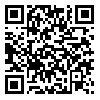Volume 17, Issue 1 (Spring 2020)
Sci J Iran Blood Transfus Organ 2020, 17(1): 36-46 |
Back to browse issues page
Abstract: (3217 Views)
Abstract
Background and Objectives
The main antigens of the Rh blood group system (D,C,c,E,e) after the ABO system, are the most immune antigens. Due to existence of donor's red blood cells in the patient's circulation serologic methods can not accurately detect blood group antigens in patients with chronic blood transfusions, but molecular methods can overcome many of these limitations.
Materials and Methods
In this cross sectional descriptive study, peripheral blood samples were taken from two hundred of alloimmunized thalassemic patients including 81 (40.5%) male and 119 (59.5%) female with mean age of 30 ± 10.9 (age range 4-65) at Tehran Thalassemia Clinic during 1976-96. Phenotyping was done for C,c,E,e antigens. Sequence Specific Primers (SSPs)-PCR was performed and the discrepant results between the phenotype and genotyping were confirmed by DNA sequencing.
Results
In this study, the highest prevalence of alloantibodies in the Rh system pertained to Anti-E 22% (44 patients) and Anti-D 10% (20 patients) and the frequency of the alleles in this blood group was determined C 71% (142), c 72.5% (145), E 23% (46), e 98% (196). Thirty eight out of 200 patients had different results between serology and genotype. Discrepancies were 7.5% (14) (RHC), 6% (11) (RHc), 9.5% (17) (RHE), and 1.5% (3) (RHe).
Conclusions
Molecular methods can help to determine the exact antigens as a complementary method by solving the problems of the serological method.
Background and Objectives
The main antigens of the Rh blood group system (D,C,c,E,e) after the ABO system, are the most immune antigens. Due to existence of donor's red blood cells in the patient's circulation serologic methods can not accurately detect blood group antigens in patients with chronic blood transfusions, but molecular methods can overcome many of these limitations.
Materials and Methods
In this cross sectional descriptive study, peripheral blood samples were taken from two hundred of alloimmunized thalassemic patients including 81 (40.5%) male and 119 (59.5%) female with mean age of 30 ± 10.9 (age range 4-65) at Tehran Thalassemia Clinic during 1976-96. Phenotyping was done for C,c,E,e antigens. Sequence Specific Primers (SSPs)-PCR was performed and the discrepant results between the phenotype and genotyping were confirmed by DNA sequencing.
Results
In this study, the highest prevalence of alloantibodies in the Rh system pertained to Anti-E 22% (44 patients) and Anti-D 10% (20 patients) and the frequency of the alleles in this blood group was determined C 71% (142), c 72.5% (145), E 23% (46), e 98% (196). Thirty eight out of 200 patients had different results between serology and genotype. Discrepancies were 7.5% (14) (RHC), 6% (11) (RHc), 9.5% (17) (RHE), and 1.5% (3) (RHe).
Conclusions
Molecular methods can help to determine the exact antigens as a complementary method by solving the problems of the serological method.
| Rights and permissions | |
 |
This work is licensed under a Creative Commons Attribution-NonCommercial 4.0 International License. |



